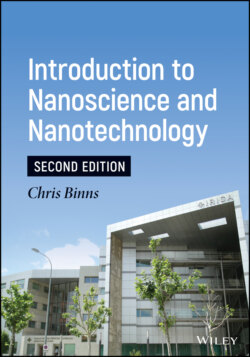Читать книгу Introduction to Nanoscience and Nanotechnology - Chris Binns - Страница 43
References
Оглавление1 1 Schüler, D. (2002). The biomineralisation of magnetosomes in Magnetospirillium gryphiswaldense. International Microbiology5: 209–214. https://doi.org/10.1007/s10123‐002‐0086‐8.
2 2 Hinds, W.C. (1999). Aerosol Technology. New York: Wiley.
3 3 Seinfeld, J.J. and Pandis, S.N. (1997). Atmospheric Chemistry and Physics: From Air Pollution to Climate Change. New York: Wiley.
4 4 Champion, J.A., Walker, A., and Mitragotri, S. (2008). Role of particle size in phagocytosis of polymeric microspheres. Pharmaceutical Research 25: 1815–1821.
5 5 Roberts, J. and Quastel, J.H. (1963). Particle uptake by polymorphonuclear leucocytes and Ehrlich ascites‐carcinoma cells. Biochemical Journal 89: 150–156.
6 6 Hoet, P.M., Brüske‐Hohlfield, I., and Salata, O.V. (2004). Nanoparticles – known and unknown health risks. Journal of Nanobiotechnology 2: 12. http://www.jnanobiotechnology.com/content/2/1/12.
7 7 Renwick, L.C., Donaldson, K., and Clouter, A. (2001). Impairment of alveolar macrophage phagocytosis by ultrafine particles. Toxicology and Applied Pharmacology 172: 119–127.
8 8 Brook, R.D., Rajagopalan, S., Pope, C.A. 3rd et al. (2010). Particulate matter air pollution and cardiovascular disease: an update to the scientific statement from the American Heart Association. Circulation 121: 2331–2378.
9 9 Miller, M.R., Raftis, J.B., Langrish, J.P. et al. (2017). Inhaled nanoparticles accumulate at sites of vascular disease. ACS Nano 11: 4542–4552. https://doi.org/10.1021/acsnano.6b0855.
10 10 Boyles, M.S.P., Stoehr, L.C., Schlinkert, P. et al. (2014). The significance and insignificance of carbon nanotube‐induced inflammation. Fibers 2: 45–74. https://doi.org/10.3390/fib2010045.
11 11 Szentkuti, L. (1997). Light microscopical observations on luminally administered dyes, dextrans, nanospheres and microspheres in the pre‐epithelial mucus gel layer of the rat distal colon. Journal of Controlled Release 46: 233–242.
12 12 Zvyagin, A.V., Zhao, X., Gierden, A. et al. (2008). Imaging of zinc oxide nanoparticle penetration in human skin in vitro and in vivo. Journal of Biomedical Optics 13: 064031.
13 13 Kreilgaard, M. (2002). Influence of microemulsions on cutaneous drug delivery. Advanced Drug Delivery Reviews 54: S77–S98.
14 14 Directive 2008/50/EC of the European Parliament and of the Council of 21 May 2008 on ambient air quality and cleaner air for Europe. http://data.europa.eu/eli/dir/2008/50/oj.
15 15 Walton, A.J. (1983). Three Phases of Matter. Oxford: Clarendon Chapter 13.
16 16 Fan, J., Rosenfeld, D., Zhang, Y. et al. (2018). Substantial convection and precipitation enhancements by ultrafine aerosol particles. Science 359: 411–418.
17 17 Clarke, A., Kapustin, V., Howell, S. et al. (2003). Sea‐salt size distributions from breaking waves. Journal of Atmospheric and Oceanic Technology 20: 1362–1374.
18 18 O'Dowd, C., Facchini, M.C., Cavalli, F. et al. (2004). Biogenically driven organic contribution to marine aerosol. Nature 431: 676–680.
19 19 Creamean, J.M., Cross, J.N., Pickart, R. et al. (2019). Ice nucleating particles carried from below a phytoplankton bloom to the arctic atmosphere. Geophysical Research Letters 46: 8572–8581. https://doi.org/10.1029/2019GL083039.
20 20 Donarummo, J. Jr., Ram, M., and Stolz, M.R. (2002). Sun/dust correlations and volcanic interference. Geophysical Research Letters 29: 75‐1–75‐4.
21 21 Clement, D., Mutschke, H., Klein, R., and Henning, T. (2003). New laboratory spectra of isolated ‐SiC nanoparticles: comparison with spectra taken by the Infrared Space Observatory. Astrophysical Journal 594: 642–650.
22 22 Postberg, F., Kempf, S., Srama, R. et al. (2006). Composition of Jovian dust stream particles. Icarus 183: 122–134.
23 23 Bentley, M., Schmied, R., Mannel, T. et al. (2016). Aggregate dust particles at comet 67P/Churyumov–Gerasimenko. Nature 537: 73–75. https://doi.org/10.1038/nature19091.
24 24 Eto, K. (1997). Pathology of Minamata disease. Toxicologic Pathology 25: 614–623.
25 25 Yirsaw, B.D., Megharaj, M., Chen, Z., and Naidu, R. (2016). Environmental application and ecological significance of nano‐zero valent iron. Journal of Environmental Sciences 44: 88–98. https://doi.org/10.1016/j.jes.2015.07.016.
26 26 Wang, C.B. and Zhang, W.X. (1997). Synthesising nanoscale iron particles for rapid and complete dichlorination of TCE and PCBs. Environmental Science and Technology 31: 2154–2156.
27 27 Crane, R.A. and Scott, T.B. (2012). Nanoscale zero‐valent iron: future prospects for an emerging water treatment technology. Journal of Hazardous Materials 211–212: 112–125. https://doi.org/10.1016/j.jhazmat.2011.11.073.
28 28 Jabeen, H., Kemp, K.C., and Chandra, V. (2013). Synthesis of nano zerovalent iron nanoparticles – graphene composite for the treatment of lead contaminated water. Journal of Environmental Management 130: 429–435. https://doi.org/10.1016/j.jenvman.2013.08.022.
29 29 Celik, G., Kennedy, R.M., Hackler, R.A. et al. (2019). Upcycling single‐use polyethylene into high‐quality liquid products. ACS Central Science 5: 1795–1803. https://doi.org/10.1021/acscentsci.9b00722.
30 30 Hedayati, A., Barnett, C.J., Swan, G., and White, A.O. (2019). Chemical recycling of consumer‐grade black plastic into electrically conductive carbon nanotubes. Journal of Carbon Research 5: 32. https://doi.org/10.3390/c5020032.
31 31 Luong, D.X., Bets, K.V., Algozeeb, W.A. et al. (2020). Gram‐scale bottom‐up flash graphene synthesis. Nature 577: 647–651. https://www.nature.com/articles/s41586‐020‐1938‐0.
